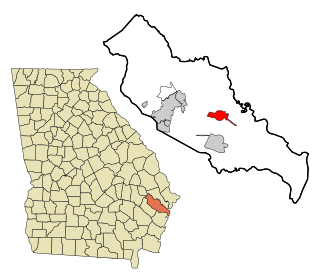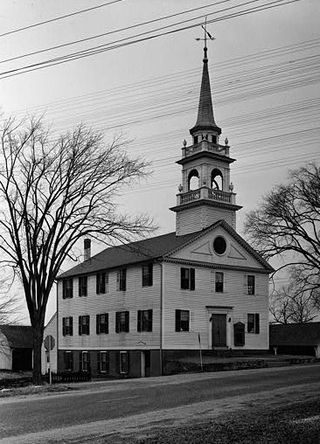
Savannah is the oldest city in the U.S. state of Georgia and the county seat of Chatham County. Established in 1733 on the Savannah River, the city of Savannah became the British colonial capital of the Province of Georgia and later the first state capital of Georgia. A strategic port city in the American Revolution and during the American Civil War, Savannah is today an industrial center and an important Atlantic seaport. It is Georgia's fifth most populous city, with a 2020 U.S. census population of 147,780. The Savannah metropolitan area, Georgia's third-largest, had a 2020 population of 404,798.

Midway is a city in Liberty County, Georgia, United States. It is a part of the Hinesville-Fort Stewart metropolitan statistical area. The population was 2,141 in 2020.

This is a list of structures, sites, districts, and objects on the National Register of Historic Places in North Carolina:

The Abington Congregational Church is a historic church on Connecticut Route 97 in the Abington village of Pomfret, Connecticut. Built in 1751 and restyled in the 1830s, it is the oldest ecclesiastical building in the State of Connecticut that has been continuously used for religious purposes. In 1977 it was included on the National Register of Historic Places.

Barryville is a hamlet in Highland, Sullivan County, New York, United States. Previously known as "The River," the hamlet was renamed for William T. Barry, postmaster general under President Andrew Jackson.

Old Stone Church is a church building built in 1802. When it was constructed, it was in the Pendleton District, South Carolina. When Pendleton District was divided in 1826, the church was in Pickens District. When Pickens District was split in 1868, it was in Oconee County, South Carolina. In 1968, this section of Oconee County was annexed back to Pickens County. The church is about midway between the centers of Pendleton and Clemson. It is now in the city limits of Clemson.

The First Congregational Church of Middletown, New York, United States is one of the most visible landmarks of that city's downtown skyline. Its spire rises higher than any other church or structure in the central neighborhoods of the city. Constructed in 1872, this is the third church built by this congregation.

Dorchester Academy was a school for African-Americans located just outside Midway, Georgia. Operating from 1869 to 1940, its campus, of which only the 1935 Dorchester Academy Boys' Dormitory survives, was the primary site of the Southern Christian Leadership Conference's Citizen Education Program. This program, ran here from 1961 to 1970, worked toward attaining equality for blacks in the American South by teaching them their rights and helping them acquire the knowledge necessary to become registered voters by passing the required test. The dormitory building was designated a U.S. National Historic Landmark in 2006 for its later role in the American civil rights movement, and for its association with activist Septima Poinsette Clark, who oversaw the education program. The campus, which includes several later buildings, is now a museum and research center.

The Little Compton Commons Historic District, or Little Compton Commons, is a historic district in Little Compton, Rhode Island. It is a triangular area roughly bounded by School House Lane to the north, South Commons Road to the east, and Meeting House Lane to the south. Properties continue to the west on West Road.

Preston City is a village and the original town center of the town of Preston, Connecticut. The core of the village around the junction of Old Northwest Road and Route 164 is designated as the Preston City Historic District, a historic district that is listed on the National Register of Historic Places. The district is located along Old Shetucket and Amos Roads, which, prior to the 1930s, were major thoroughfares.

St. Thomas Manor (1741) is a historic home and Catholic church complex located near Port Tobacco, Charles County, Maryland. Known as St. Ignatius Church and Cemetery, the manor house complex is the oldest continuously occupied Jesuit residence in the world. The mission settlement of Chapel Point was established in 1641 by Father Andrew White, S.J., an English Jesuit missionary. Father White ministered to the Potapoco Native Americans, some of whom he converted to Catholicism. Established in 1662, this is the oldest continuously active Roman Catholic parish in the American Thirteen Colonies. With the consecration in 1794 of Bishop John Carroll, St. Thomas became the first Roman Catholic see in the United States.

The Amherst Village Historic District encompasses the historic village center of Amherst, New Hampshire. Centered on the town's common, which was established about 1755, Amherst Village is one of the best examples of a late-18th to early-19th century New England village center. It is roughly bounded on the north by Foundry Street and on the south by Amherst Street, although it extends along some roads beyond both. The western boundary is roughly Davis Lane, the eastern is Mack Hill Road, Old Manchester Road, and Court House Road. The district includes the Congregational Church, built c. 1771-74, and is predominantly residential, with a large number of Georgian, Federal, and Greek Revival houses. Other notable non-residential buildings include the Farmer's Bank, a Federal-style brick building built in 1806, and the Amherst Brick School, a brick Greek Revival structure that has served as the School Administrative Unit 39 offices since 1997.

The Midway Historic District consists of 20 acres (8.1 ha) encompassing the Midway Congregational Church and Cemetery, the Midway Museum and the Old Sunbury Road, at the intersection of U.S. 17 and Martin Road in Midway, Liberty County, Georgia. The Midway Congregational Church is a large historic wooden church built in 1792 to replace an earlier church building that had been burned by the British during the Revolutionary War. Its historic cemetery also dates from the 18th century. Notable Georgians buried in it include Governor and Congressman Nathan Brownson and early U.S. Senator John Elliott. It also contains the Stewart–Screven Monument, honoring two generals from the Continental Army. The Midway Museum is housed in a modern reconstruction of a typical 18th century raised cottage such as those that once existed in the area. The Old Sunbury Road section that runs past the district is a remnant of the road built during the early years of Georgia's statehood. On March 1, 1973, the Midway Historic District was added to the National Register of Historic Places.

Bethel Cemetery is a cemetery in rural western Lawrence County, Arkansas. It is located off County Road 225, about 1.1 miles (1.8 km) north of Arkansas Highway 117, roughly midway between Black Rock and Smithville. Its oldest portion occupies a roughly triangular parcel of land, surrounded by a perimeter road, with a gate at the eastern corner. It is located next to the site of a church which was established in the 1820s, and its oldest grave is supposedly the 1835 burial of an American Revolutionary War veteran. The oldest dated grave marker is marked 1858, and the cemetery continues to be used today. The cemetery is a reminder of the community of Denton, which flourished in the mid-19th century, but declined after it was bypassed by the railroad.

The Peacham Corner Historic District encompasses much of the historic village center of Peacham, Vermont. The village's period of greatest growth and importance between the town's founding as a hill town in the late 18th century, and 1860, when significant development effectively ended. As a result, the village lacks Victorian features often found in other rural communities. The district was listed on the National Register of Historic Places in 2003.

The Ebenezer Gay House, also known locally as the Gay-Hoyt House, is a historic house museum at 18 Main Street in Sharon, Connecticut. Built in 1775, it is a well-preserved example of Georgian colonial architecture in brick. It was listed on the National Register of Historic Places in 1979, and is part of the Sharon Historic District, listed in 1993. It is now home to the Sharon Historical Society.

The Old City Cemetery is a small cemetery located in Macon, Georgia, United States. Established in 1825, it saw burials until the 1840s, when Rose Hill Cemetery, a much larger cemetery in the city, opened. Following this, the cemetery fell into ruins, and following failed efforts in the late 1800s to convert the area to a public park, the cemetery was restored in the 1970s. The cemetery is located in the Macon Railroad Industrial District, which is listed on the National Register of Historic Places.


















